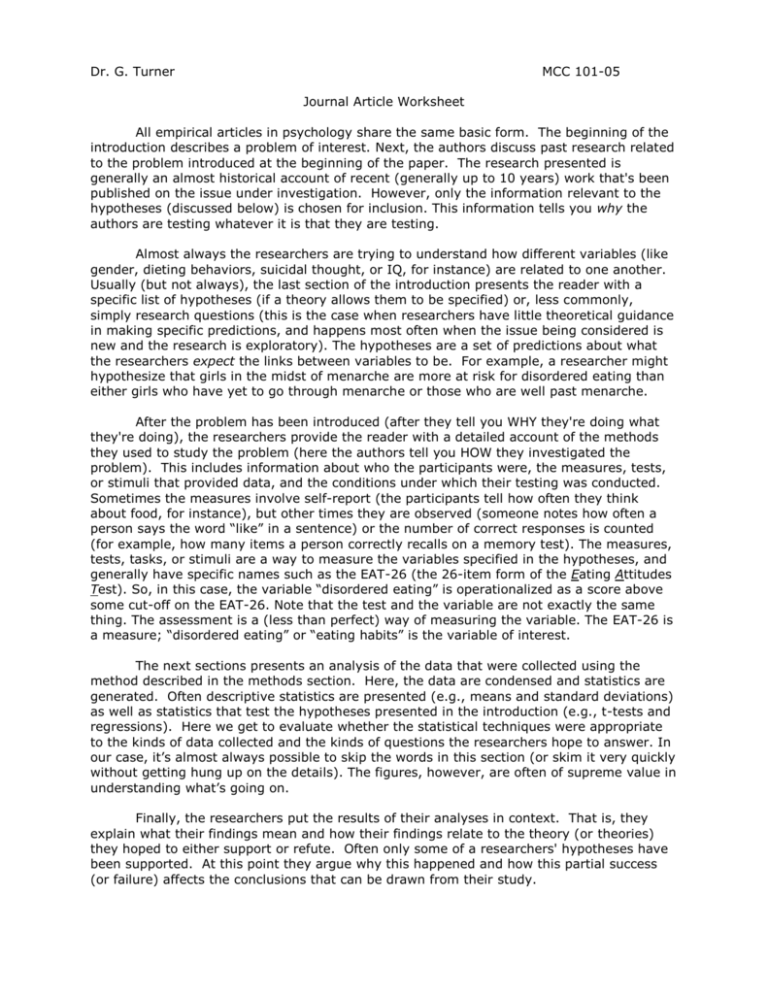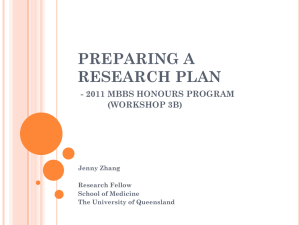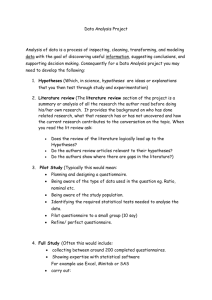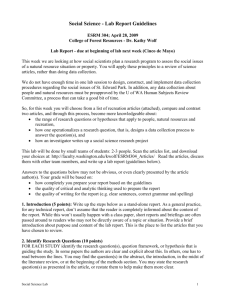journal article worksheet
advertisement

Dr. G. Turner MCC 101-05 Journal Article Worksheet All empirical articles in psychology share the same basic form. The beginning of the introduction describes a problem of interest. Next, the authors discuss past research related to the problem introduced at the beginning of the paper. The research presented is generally an almost historical account of recent (generally up to 10 years) work that's been published on the issue under investigation. However, only the information relevant to the hypotheses (discussed below) is chosen for inclusion. This information tells you why the authors are testing whatever it is that they are testing. Almost always the researchers are trying to understand how different variables (like gender, dieting behaviors, suicidal thought, or IQ, for instance) are related to one another. Usually (but not always), the last section of the introduction presents the reader with a specific list of hypotheses (if a theory allows them to be specified) or, less commonly, simply research questions (this is the case when researchers have little theoretical guidance in making specific predictions, and happens most often when the issue being considered is new and the research is exploratory). The hypotheses are a set of predictions about what the researchers expect the links between variables to be. For example, a researcher might hypothesize that girls in the midst of menarche are more at risk for disordered eating than either girls who have yet to go through menarche or those who are well past menarche. After the problem has been introduced (after they tell you WHY they're doing what they're doing), the researchers provide the reader with a detailed account of the methods they used to study the problem (here the authors tell you HOW they investigated the problem). This includes information about who the participants were, the measures, tests, or stimuli that provided data, and the conditions under which their testing was conducted. Sometimes the measures involve self-report (the participants tell how often they think about food, for instance), but other times they are observed (someone notes how often a person says the word “like” in a sentence) or the number of correct responses is counted (for example, how many items a person correctly recalls on a memory test). The measures, tests, tasks, or stimuli are a way to measure the variables specified in the hypotheses, and generally have specific names such as the EAT-26 (the 26-item form of the Eating Attitudes Test). So, in this case, the variable “disordered eating” is operationalized as a score above some cut-off on the EAT-26. Note that the test and the variable are not exactly the same thing. The assessment is a (less than perfect) way of measuring the variable. The EAT-26 is a measure; “disordered eating” or “eating habits” is the variable of interest. The next sections presents an analysis of the data that were collected using the method described in the methods section. Here, the data are condensed and statistics are generated. Often descriptive statistics are presented (e.g., means and standard deviations) as well as statistics that test the hypotheses presented in the introduction (e.g., t-tests and regressions). Here we get to evaluate whether the statistical techniques were appropriate to the kinds of data collected and the kinds of questions the researchers hope to answer. In our case, it’s almost always possible to skip the words in this section (or skim it very quickly without getting hung up on the details). The figures, however, are often of supreme value in understanding what’s going on. Finally, the researchers put the results of their analyses in context. That is, they explain what their findings mean and how their findings relate to the theory (or theories) they hoped to either support or refute. Often only some of a researchers' hypotheses have been supported. At this point they argue why this happened and how this partial success (or failure) affects the conclusions that can be drawn from their study. 1. In your own words, describe the authors’ hypotheses. What predictions did the author(s) make about the relations among the variables of interest? (Note: sometimes it’s helpful to skip to #3 to make sure you’ve got all of the variables then come back to this item to make sure you see how they are all related. Often a simple picture or diagram helps). 2. Why are they testing what they’re testing? In your own words, briefly describe how the researchers came up with their hypotheses? For example, if a researcher hypothesized that girls in the midst of menarche are most likely to have disordered eating, they may have done so because previous research has shown that the number of transitions a teen undergoes simultaneously predicts higher levels of stress and higher levels of stress predict problem eating. Consequently, the researchers' hypotheses are the next logical step in this sequence of ideas. So, what was the logic behind the researchers’ hypotheses? 3. In your own words, describe the tasks, tests, or assessments that the researchers used to test their hypotheses. Make sure that any variables you noted in #1 have a measurement tool here. If #1 and #3 don’t match, you’ve probably (but not necessarily) missed something. 4. In your own words, describe what the researchers found. What was the actual relation between the variables? Were the researchers correct in #1? As with #1, a figure or diagram is often indispensible.








